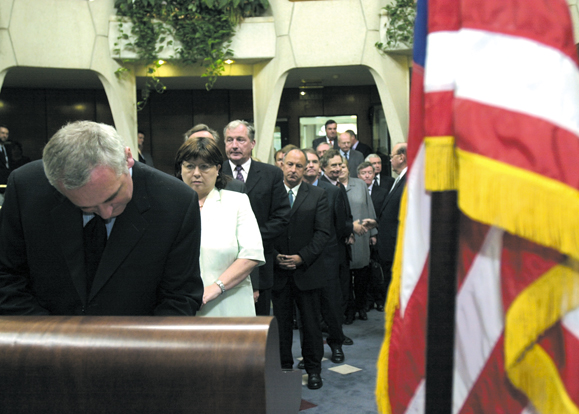Thousands of people queued for hours in front of the American Embassy in Ballsbridge, Dublin, waiting patiently to sign one of the many books of condolences to be presented to the U.S. government in the aftermath of September 11. At John F. Kennedy’s ancestral home in Dunganstown, Co. Wexford, the U.S. flag flew at half-mast and the house was closed to visitors.
As it was on the day that he was assassinated, everyone remembers where they were on September 11. But on September 14 in Ireland, the churches were full and the offices, shops and pubs dark and silent as the country mourned with its American relatives, colleagues and friends. The day was declared by the Irish government as a National Day of Mourning.
Bouquets of flowers, teddy bears, candles and messages were left at the Embassy, as thousands stood with heads bowed. The building’s facade was turned into a shrine to those who died in New York and Washington, and there were both tears and applause when 250 firefighters from all over Ireland paraded past the Embassy as a mark of respect to the hundreds of firefighters lost in New York. People wept openly as they heard of the casualties and more details emerged of that terrible morning.
The nation prayed as industrial and commercial life came to a halt and offices, government departments and all places of entertainment closed for mourning. In every parish and diocese religious services were held, with the biggest, an ecumenical service in Dublin, being attended by Taoiseach Bertie Ahern, President Mary McAleese and many other cabinet members. At least 2,000 people tried to squeeze into the Pro-Cathedral, which holds only 1,500. Outside, a group of U.S. students broke into the American national anthem, and the crowd fell still.
The bells of Christ Church Cathedral rang muffled for 90 minutes to mark the occasion, and at 11 a.m. towns and villages fell silent as the people joined in a European-wide three minutes of silence. At noon, all trains stopped for five minutes and special services were held in practically every town in the country. In Bray, County Wicklow, so many people showed up that the church ran out of communion. A number of people approaching the altar were given a blessing instead.
People are still dealing with the aftermath of the attacks. In Dublin’s universities, Irish students who were present in New York at the time are being offered free counseling to help them deal with the “nightmares and flashbacks.”
And a fund for the families of the victims started by Independent News and Media, which donated the money from the sales of all its newspapers on September 14, reached more than 120,000 punts. It was given to The American Ireland Fund in the presence of U.S. Ambassador to Ireland, Richard Egan. Money is still being collected throughout the country. ♦


Leave a Reply